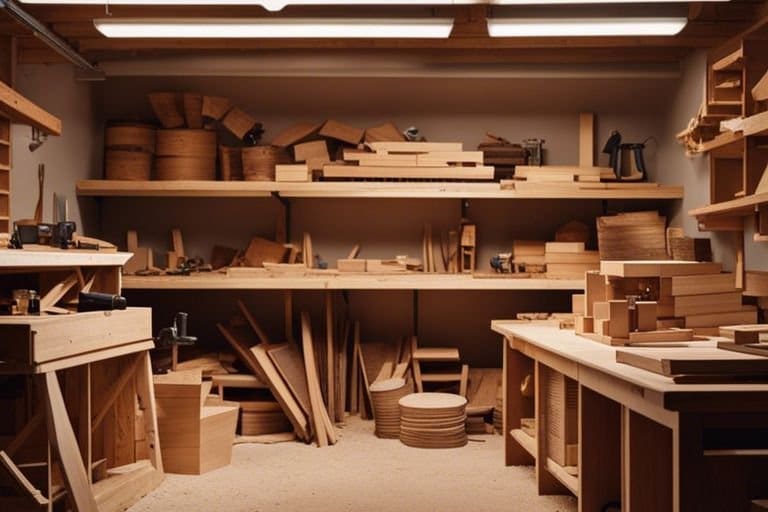Intricate cuts require precision and finesse, much like crafting a masterpiece in woodworking. With the right technique and a bit of practice, using a backsaw can elevate your woodworking projects to the next level. Let’s explore the art of using a backsaw for those intricate cuts and unlock the secrets that will take your woodworking skills to new heights.
The Basics of Backsaws
Your journey to mastering the fine art of using a backsaw begins with understanding the basics. A backsaw is a type of handsaw with a stiffening rib on the edge opposite the cutting edge, allowing for more precise and controlled cuts. The stiffening rib, or back, gives the blade support, making it ideal for intricate woodworking tasks that require accuracy.
What is a Backsaw?
Any woodworking enthusiast knows that a backsaw is imperative for making clean and straight cuts in delicate woodwork. Unlike a regular handsaw, a backsaw has a thin blade with fine teeth that are designed for fine woodworking tasks like joinery, trim work, and dovetailing. The fine teeth minimize tear-out, leaving behind a smooth and professional finish on your wood projects.
Choosing the Right Backsaw for the Job
The key to mastering the art of using a backsaw lies in choosing the right tool for the job. The size and teeth-per-inch (TPI) of the backsaw blade will determine the type of cuts you can make. For finer and more precise cuts, opt for a backsaw with higher TPI, while a lower TPI is suitable for rougher cuts. Additionally, consider the length of the blade – longer blades are better suited for larger workpieces, while shorter blades offer more maneuverability for intricate cuts.
Understanding the different types of backsaws available, such as tenon saws, dovetail saws, and carcass saws, will help you select the perfect tool for your woodworking projects. Each type of backsaw is designed for specific tasks, so having a variety of backsaws in your workshop will ensure you are prepared for any woodworking challenge that comes your way.
Preparing for Intricate Cuts
Selecting the Right Wood
An imperative step in preparing for intricate cuts with a backsaw is selecting the right type of wood. Look for straight-grained wood like maple, cherry, or walnut, as they are less prone to tear out and splintering when making intricate cuts. These woods also offer a good balance between hardness and workability, making them ideal for detailed work with a backsaw.
Measuring and Marking Your Cuts
Any woodworking project, especially those involving intricate cuts, relies heavily on accurate measurements and markings. Before making any cuts, ensure your measurements are precise and double-check them to avoid errors. Use a sharp pencil or marking knife to mark the cut lines clearly on the wood, as these will serve as your guide when using the backsaw.
For intricate cuts, consider using a marking gauge or a cutting gauge to score the wood lightly along the cut line. This step helps create a groove for the saw’s teeth to follow, resulting in cleaner and more accurate cuts.
Understanding Setting Up Your Workspace
Your workspace plays a crucial role in the success of your intricate cuts with a backsaw. Ensure your workbench is stable and at a comfortable height for sawing. Lighting is also imperative, so make sure your workspace is well-lit to see your cut lines clearly and avoid any mishaps. Organize your tools and keep a clean workspace to prevent clutter that could interfere with your cutting precision.
Mastering the Grip
After selecting the right backsaw for your intricate cuts, the next step is mastering the grip. The way you hold the saw significantly impacts the precision and control you have over the cuts you make.
The Importance of a Comfortable Grip
An vital aspect of using a backsaw effectively is maintaining a comfortable grip throughout your cutting tasks. A relaxed yet firm grip helps in controlling the saw’s movement and making accurate cuts. Gripping too tightly can lead to strain and fatigue, while holding too loosely may result in the saw slipping or veering off course. Experiment with different grip pressures until you find the sweet spot that allows you to maneuver the saw smoothly and with ease.
Finding Your Natural Grip Style
On your woodworking journey, you’ll discover that each craftsman has a unique grip style that suits them best. Some might prefer an overhand grip for better control, while others find an underhand grip more comfortable. The key is to find a grip that feels natural to you and gives you the most control over the saw’s movements.
The process of finding your natural grip style involves experimentation and practice. Try different hand positions and grips while making practice cuts on scrap wood to see which one works best for you. Keep in mind, there’s no one-size-fits-all approach when it comes to grip, so find what feels right for you.
Adjusting Your Grip for Different Cuts
The key to mastering the art of using a backsaw for intricate cuts lies in being able to adjust your grip depending on the type of cut you’re making. For crosscuts, where you’re cutting across the wood grain, a slightly tighter grip may be necessary to maintain control and accuracy. In contrast, when making rip cuts along the grain, a looser grip combined with a smooth, fluid motion can yield cleaner cuts.
Any changes in grip pressure should be subtle and responsive to the cutting task at hand. Remember to always maintain a comfortable grip to prevent hand fatigue and ensure consistent, high-quality cuts.
Grip
Cutting Techniques
Unlike power saws, which can make quick work of straight lines and angles, backsaws require a bit more finesse and skill to master. Let’s explore some cutting techniques that will help you become proficient in using a backsaw for intricate cuts.
The Push-Pull Method
With the push-pull method, you apply pressure on both the forward and backward strokes of the saw. This technique helps to maintain a straight cut and prevents the saw from binding in the wood. By evenly distributing the pressure, you can achieve smooth and precise cuts without straining your arm muscles.
The Gentle Touch
Touch lightly on the saw handle as you guide it through the wood. Too much pressure can cause the saw to veer off course or create rough edges in delicate cuts. By mastering the gentle touch, you can let the sharp teeth of the backsaw do the work for you, resulting in clean and accurate cuts.
Having a delicate approach to using a backsaw is crucial, especially when working on intricate designs or detailed woodworking projects. Practice controlling the pressure you exert on the saw to achieve the desired depth and precision in your cuts.
Cutting Curves and Corners
Techniques for cutting curves and corners with a backsaw require a combination of steady hands and strategic maneuvering. Start by making relief cuts to remove excess wood and create space for the saw to navigate tight turns. Tilt the saw slightly to follow the curvature of the design while maintaining a steady pace to prevent the wood from splintering.
Cutting curves and corners with a backsaw can be challenging but rewarding, as it allows you to add intricate details and unique shapes to your woodworking projects. With practice and patience, you can master these techniques and elevate your woodworking skills to the next level.
Common Challenges and Solutions
Dealing with Kickback
With the fine art of using a backsaw, one common challenge that woodworkers face is kickback, where the saw jumps back towards the user unexpectedly. To prevent this, ensure that the saw blade is sharp and properly tensioned. Additionally, maintaining a firm grip on the saw and keeping your body positioned correctly can help mitigate kickback. Always remember to follow proper sawing techniques to reduce the risk of kickback.
Overcoming Blade Binding
For intricate cuts, blade binding can be a frustrating issue. It occurs when the saw blade gets stuck in the wood due to heat buildup or misalignment. To overcome this, make sure the saw blade is inserted correctly and is sharp. Avoid forcing the saw through the cut; instead, let the tool do the work. If you encounter blade binding, stop immediately, remove the saw, and reassess the cut to prevent damage to the blade or the wood.
Blade binding can be a common issue when working with intricate cuts that require precision and finesse. By understanding why blade binding occurs and taking steps to prevent it, you can improve the quality of your cuts and enhance your woodworking skills.
Fixing Mistakes and Errors
Overcoming mistakes and errors is an crucial skill for any woodworker, and using a backsaw for intricate cuts is no different. If you find that you’ve made a mistake, don’t panic. Take a step back, assess the situation, and determine the best course of action to correct the error. Whether it’s adjusting the angle of the cut or using a different sawing technique, there are often solutions to fix mistakes and improve the outcome of your project.
For instance, if you accidentally veer off course while making a delicate cut, don’t fret. You can use a chisel or sandpaper to refine the edge and make it appear seamless. Embracing mistakes as learning opportunities can help you grow as a woodworker and become more proficient in using a backsaw for intricate cuts.
Advanced Techniques
All budding woodworkers know the importance of mastering the art of using a backsaw for intricate cuts. Moving beyond the basics, let’s explore into some advanced techniques that will take your woodworking skills to the next level.
-
Cutting Dovetails and Tenons
On a finer note, cutting dovetails and tenons with precision is a hallmark of craftsmanship. When using a backsaw for these joints, ensure a sharp blade and a steady hand for clean and accurate cuts. -
Creating Intricate Joints
Advanced Mastering the art of creating intricate joints, such as half-blind dovetails or compound angles, requires patience and precision. Use your backsaw to carefully cut along the marked lines, ensuring a tight fit for a strong joint.
Cutting Dovetails and Tenons
On a finer note, cutting dovetails and tenons with precision is a hallmark of craftsmanship. When using a backsaw for these joints, ensure a sharp blade and a steady hand for clean and accurate cuts.
Creating Intricate Joints
Advanced woodworkers take pride in creating intricate joints that not only hold pieces together but also add aesthetic value to the final piece. This level of craftsmanship requires a keen eye for detail and the ability to execute precise cuts with a backsaw.
Using Backsaws for Decorative Cuts
An vital skill for any woodworker is using backsaws for decorative cuts. Whether it’s creating intricate patterns or adding decorative edges to your projects, a backsaw can be a versatile tool in your woodworking arsenal.
Tenons are a type of joint where one piece of wood is inserted into a slot in another piece. Using a backsaw to cut tenons requires careful measurement and precise cutting to ensure a snug fit for a strong joint.
Conclusion
Following this instructional article, you should now have a better understanding of how to use a backsaw for intricate cuts in your woodworking projects. By mastering the fine art of using a backsaw, you can achieve more precise and detailed cuts, taking your craftsmanship to the next level.
Remember to practice your technique and be patient as you hone your skills with the backsaw. With dedication and persistence, you will soon be creating beautiful and intricate woodworking designs that showcase your mastery of this versatile tool.




